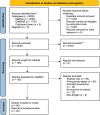Laparoscopic versus robotic abdominal and pelvic surgery: a systematic review of randomised controlled trials
- PMID: 37442833
- PMCID: PMC10462573
- DOI: 10.1007/s00464-023-10275-8
Laparoscopic versus robotic abdominal and pelvic surgery: a systematic review of randomised controlled trials
Abstract
Background: The current evidence is inconclusive on whether robotic or laparoscopic surgery is the optimal platform for minimally invasive surgery. Existing comparisons techniques focus on short-term outcomes only, while potentially being confounded by a lack of standardisation in robotic procedures. There is a pertinent need for an up-to-date comparison between minimally invasive surgical techniques. We aimed to systematically review randomised controlled trials comparing robotic and laparoscopic techniques in major surgery.
Methods: Embase, Medline and Cochrane Library were searched from their inception to 13th September 2022. Included studies were randomised controlled trials comparing robotic and laparoscopic techniques in abdominal and pelvic surgery. The study followed the Preferred Reporting Items for Systematic Reviews and Meta-Analyses (PRISMA) guidelines. Short-term, health-related quality of life, and long-term, outcomes were analysed.
Results: Forty-five studies, across thirteen procedures, involving 7364 patients were included. All of the studies reported non-significant differences in mortality between robotic and laparoscopic surgery. In majority of studies, there was no significant difference in complication rate (n = 31/35, 85.6%), length of postoperative stay (n = 27/32, 84.4%), and conversion rate (n = 15/18, 83.3%). Laparoscopic surgery was associated with shorter operative time (n = 16/31, 51.6%) and lower total cost (n = 11/13, 84.6%). Twenty three studies reported on quality of life outcomes; majority (n = 14/23, 60.9%) found no significant differences.
Conclusion: There were no significant differences between robotic surgery and laparoscopic surgery with regards to mortality and morbidity outcomes in the majority of studies. Robotic surgery was frequently associated with longer operative times and higher overall cost. Selected studies found potential benefits in post-operative recovery time, and patient-reported outcomes; however, these were not consistent across procedures and trials, with most studies being underpowered to detect differences in secondary outcomes. Future research should focus on assessing quality of life, and long-term outcomes to further elucidate where the robotic platform could lead to patient benefits, as the technology evolves.
Keywords: Laparoscopic surgery; Robotic surgery; Surgical outcomes; Systematic review.
© 2023. Crown.
Conflict of interest statement
Dr Yuman Fong is a scientific consultant for Medtronic. Mr Michal Kawka and Ms Tamara MH Gall have no conflicts of interest or financial ties to disclose.
Figures



Similar articles
-
Clinical effectiveness and cost-effectiveness of laparoscopic surgery for colorectal cancer: systematic reviews and economic evaluation.Health Technol Assess. 2006 Nov;10(45):1-141, iii-iv. doi: 10.3310/hta10450. Health Technol Assess. 2006. PMID: 17083853
-
Systemic pharmacological treatments for chronic plaque psoriasis: a network meta-analysis.Cochrane Database Syst Rev. 2021 Apr 19;4(4):CD011535. doi: 10.1002/14651858.CD011535.pub4. Cochrane Database Syst Rev. 2021. Update in: Cochrane Database Syst Rev. 2022 May 23;5:CD011535. doi: 10.1002/14651858.CD011535.pub5. PMID: 33871055 Free PMC article. Updated.
-
Surgical approach to hysterectomy for benign gynaecological disease.Cochrane Database Syst Rev. 2023 Aug 29;8(8):CD003677. doi: 10.1002/14651858.CD003677.pub6. Cochrane Database Syst Rev. 2023. PMID: 37642285 Free PMC article.
-
Antidepressants for pain management in adults with chronic pain: a network meta-analysis.Health Technol Assess. 2024 Oct;28(62):1-155. doi: 10.3310/MKRT2948. Health Technol Assess. 2024. PMID: 39367772 Free PMC article.
-
Systemic pharmacological treatments for chronic plaque psoriasis: a network meta-analysis.Cochrane Database Syst Rev. 2017 Dec 22;12(12):CD011535. doi: 10.1002/14651858.CD011535.pub2. Cochrane Database Syst Rev. 2017. Update in: Cochrane Database Syst Rev. 2020 Jan 9;1:CD011535. doi: 10.1002/14651858.CD011535.pub3. PMID: 29271481 Free PMC article. Updated.
Cited by
-
Surgical Treatment of Enlarged Cervical Leiomyoma with Concomitant Uterine Prolapse: A Case Report.J Clin Med. 2024 Jul 19;13(14):4210. doi: 10.3390/jcm13144210. J Clin Med. 2024. PMID: 39064250 Free PMC article.
-
A Systematic Review of Ureteral Reimplantation Techniques in Endometriosis: Laparoscopic Versus Robotic-Assisted Approach.J Clin Med. 2024 Sep 24;13(19):5677. doi: 10.3390/jcm13195677. J Clin Med. 2024. PMID: 39407736 Free PMC article. Review.
-
Artificial intelligence in surgery.Nat Med. 2024 May;30(5):1257-1268. doi: 10.1038/s41591-024-02970-3. Epub 2024 May 13. Nat Med. 2024. PMID: 38740998 Review.
-
Analysis of the impact on sexual function in early-onset overweight male patients with rectal cancer following robotic surgery.J Robot Surg. 2024 Sep 30;18(1):357. doi: 10.1007/s11701-024-02085-4. J Robot Surg. 2024. PMID: 39348029
-
Evaluation of a newly developed oral and maxillofacial surgical robotic platform (KD-SR-01) in head and neck surgery: a preclinical trial in porcine models.Int J Oral Sci. 2024 Jul 10;16(1):51. doi: 10.1038/s41368-024-00318-8. Int J Oral Sci. 2024. PMID: 38987554 Free PMC article.
References
Publication types
MeSH terms
LinkOut - more resources
Full Text Sources

